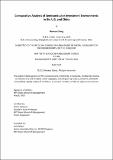| dc.description.abstract | Semiconductors are fundamental to Artificial Intelligence(AI) and central to global technological competition. Against this backdrop, this thesis compares semiconductor primary investment environments in the United States and China, examining their implications for industry development and innovation. The study employs a mixed-methods approach, combining expert interviews, data analysis, and natural language processing (NLP). It draws on primary market investment, M&A deals and government grants data to examine capital structures, investment stages, sectoral focus, and exit efficiency. Furthermore, it analyzes nearly 3,000 semiconductor industry reports(2020-2025) to identify evolving strategic priorities and thematic trends shaping these environments. Findings reveal that China’s state-led, vertically integrated model prioritizes upstream capacity building and supply chain autonomy, supported by government guidance funds, private capital, and policy-driven mechanisms. However, there remains a significant gap in leading-edge chips, necessitating precise investments and patient capital to bridge this divide. While the U.S. ecosystem, shaped by major technology firms and federal support, focuses on design innovation and cutting-edge technologies. However, structural constraints such as limited exit pathways, fragmented fabrication capacity, and insufficient industrial policies may hinder the U.S. in nurturing innovation-driven small and medium-sized enterprises (SMEs) in the semiconductor industry. This thesis highlights the structural divergence between the U.S. and China’s semiconductor ecosystems by examining policy, primary market capital, and investment dynamics. It offers policymakers and investors a strategic overview of how these forces shape innovation and resilience, while identifying emerging investment priorities and future development paths. | |
